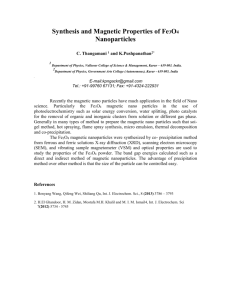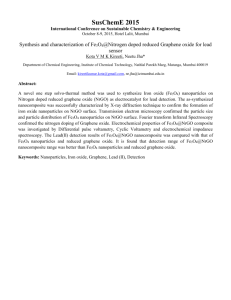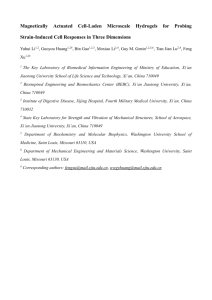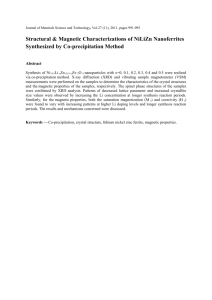1 Laboratory of Cytogenetics, West Pomeranian University of
advertisement
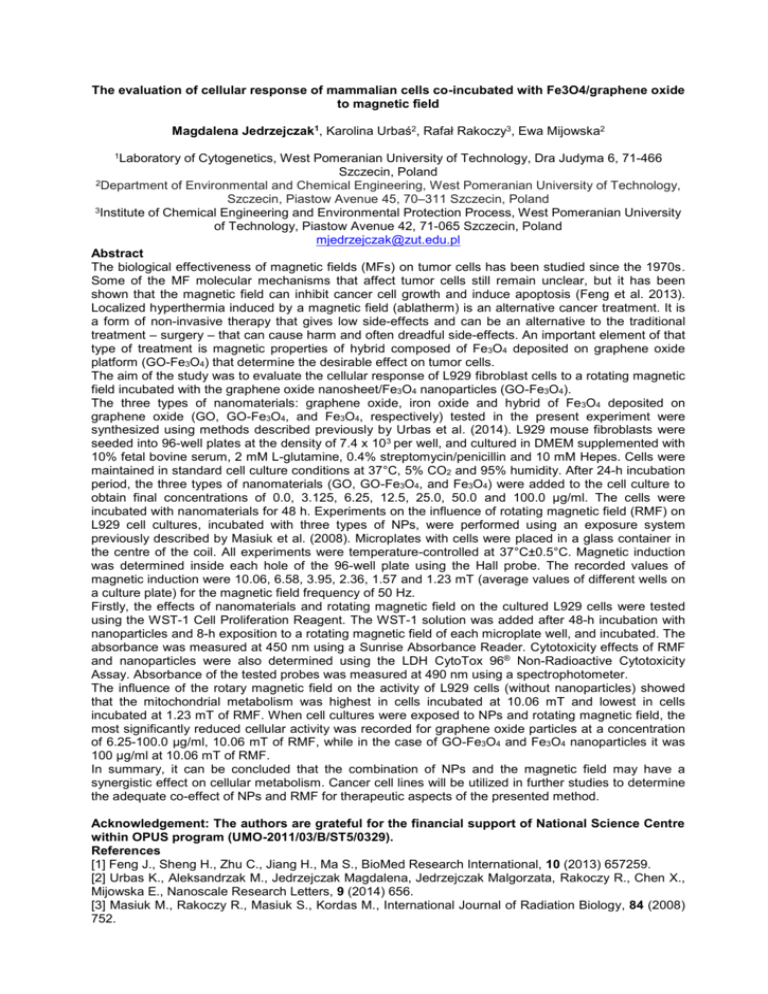
The evaluation of cellular response of mammalian cells co-incubated with Fe3O4/graphene oxide to magnetic field Magdalena Jedrzejczak1, Karolina Urbaś2, Rafał Rakoczy3, Ewa Mijowska2 1Laboratory of Cytogenetics, West Pomeranian University of Technology, Dra Judyma 6, 71-466 Szczecin, Poland 2Department of Environmental and Chemical Engineering, West Pomeranian University of Technology, Szczecin, Piastow Avenue 45, 70–311 Szczecin, Poland 3Institute of Chemical Engineering and Environmental Protection Process, West Pomeranian University of Technology, Piastow Avenue 42, 71-065 Szczecin, Poland mjedrzejczak@zut.edu.pl Abstract The biological effectiveness of magnetic fields (MFs) on tumor cells has been studied since the 1970s. Some of the MF molecular mechanisms that affect tumor cells still remain unclear, but it has been shown that the magnetic field can inhibit cancer cell growth and induce apoptosis (Feng et al. 2013). Localized hyperthermia induced by a magnetic field (ablatherm) is an alternative cancer treatment. It is a form of non-invasive therapy that gives low side-effects and can be an alternative to the traditional treatment – surgery – that can cause harm and often dreadful side-effects. An important element of that type of treatment is magnetic properties of hybrid composed of Fe3O4 deposited on graphene oxide platform (GO-Fe3O4) that determine the desirable effect on tumor cells. The aim of the study was to evaluate the cellular response of L929 fibroblast cells to a rotating magnetic field incubated with the graphene oxide nanosheet/Fe3O4 nanoparticles (GO-Fe3O4). The three types of nanomaterials: graphene oxide, iron oxide and hybrid of Fe3O4 deposited on graphene oxide (GO, GO-Fe3O4, and Fe3O4, respectively) tested in the present experiment were synthesized using methods described previously by Urbas et al. (2014). L929 mouse fibroblasts were seeded into 96-well plates at the density of 7.4 x 103 per well, and cultured in DMEM supplemented with 10% fetal bovine serum, 2 mM L-glutamine, 0.4% streptomycin/penicillin and 10 mM Hepes. Cells were maintained in standard cell culture conditions at 37°C, 5% CO2 and 95% humidity. After 24-h incubation period, the three types of nanomaterials (GO, GO-Fe3O4, and Fe3O4) were added to the cell culture to obtain final concentrations of 0.0, 3.125, 6.25, 12.5, 25.0, 50.0 and 100.0 µg/ml. The cells were incubated with nanomaterials for 48 h. Experiments on the influence of rotating magnetic field (RMF) on L929 cell cultures, incubated with three types of NPs, were performed using an exposure system previously described by Masiuk et al. (2008). Microplates with cells were placed in a glass container in the centre of the coil. All experiments were temperature-controlled at 37°C±0.5°C. Magnetic induction was determined inside each hole of the 96-well plate using the Hall probe. The recorded values of magnetic induction were 10.06, 6.58, 3.95, 2.36, 1.57 and 1.23 mT (average values of different wells on a culture plate) for the magnetic field frequency of 50 Hz. Firstly, the effects of nanomaterials and rotating magnetic field on the cultured L929 cells were tested using the WST-1 Cell Proliferation Reagent. The WST-1 solution was added after 48-h incubation with nanoparticles and 8-h exposition to a rotating magnetic field of each microplate well, and incubated. The absorbance was measured at 450 nm using a Sunrise Absorbance Reader. Cytotoxicity effects of RMF and nanoparticles were also determined using the LDH CytoTox 96® Non-Radioactive Cytotoxicity Assay. Absorbance of the tested probes was measured at 490 nm using a spectrophotometer. The influence of the rotary magnetic field on the activity of L929 cells (without nanoparticles) showed that the mitochondrial metabolism was highest in cells incubated at 10.06 mT and lowest in cells incubated at 1.23 mT of RMF. When cell cultures were exposed to NPs and rotating magnetic field, the most significantly reduced cellular activity was recorded for graphene oxide particles at a concentration of 6.25-100.0 µg/ml, 10.06 mT of RMF, while in the case of GO-Fe3O4 and Fe3O4 nanoparticles it was 100 µg/ml at 10.06 mT of RMF. In summary, it can be concluded that the combination of NPs and the magnetic field may have a synergistic effect on cellular metabolism. Cancer cell lines will be utilized in further studies to determine the adequate co-effect of NPs and RMF for therapeutic aspects of the presented method. Acknowledgement: The authors are grateful for the financial support of National Science Centre within OPUS program (UMO-2011/03/B/ST5/0329). References [1] Feng J., Sheng H., Zhu C., Jiang H., Ma S., BioMed Research International, 10 (2013) 657259. [2] Urbas K., Aleksandrzak M., Jedrzejczak Magdalena, Jedrzejczak Malgorzata, Rakoczy R., Chen X., Mijowska E., Nanoscale Research Letters, 9 (2014) 656. [3] Masiuk M., Rakoczy R., Masiuk S., Kordas M., International Journal of Radiation Biology, 84 (2008) 752.
